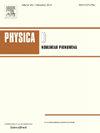一类近可积系统位移图的局部和全局分析
IF 2.9
3区 数学
Q1 MATHEMATICS, APPLIED
引用次数: 0
摘要
本文介绍了在平面上应用1阶和2阶平均理论的另一种方法。这是通过结合位移映射的泰勒展开式和庞加莱姆-波因特里亚金-梅尔尼科夫函数的积分形式来实现的。已知,要用平均理论得到2阶结果,一阶平均函数必须等于零。然而,当使用i阶平均函数的泰勒展开式时,我们通常不能保证它等于零。证明了一阶平均函数的泰勒级数某些系数的消失保证了它是同零的。我们在几个具体的例子中给出了我们的推理:一个二次的Lotka-Volterra系统,一个二次的hamilton系统,整个二次等时微分系统族,以及一个三次系统。对于后者,我们也表明,以前的分析包含在文献中是不正确的。在所有的例子中,都不需要精确地计算平均函数。本文章由计算机程序翻译,如有差异,请以英文原文为准。
Local and global analysis of the displacement map for some near integrable systems
In this paper, we introduce an alternative method for applying averaging theory of orders 1 and 2 in the plane. This is done by combining Taylor expansions of the displacement map with the integral form of the Poincaré–Poyntriagin–Melnikov function. It is known that, to obtain results of order 2 with averaging theory, the first-order averaging function should be identically zero. However, when working with Taylor expansions of the th-order averaging function, we usually cannot guarantee it is identically zero. We prove that the vanishing of certain coefficients of the Taylor series of the first-order averaging function ensures it is identically zero. We present our reasoning in several concrete examples: a quadratic Lotka–Volterra system, a quadratic Hamiltonian system, the entire family of quadratic isochronous differential systems, and a cubic system. For the latter, we also show that a previous analysis contained in the literature is not correct. In none of the examples is it necessary to precisely calculate the averaging functions.
求助全文
通过发布文献求助,成功后即可免费获取论文全文。
去求助
来源期刊

Physica D: Nonlinear Phenomena
物理-物理:数学物理
CiteScore
7.30
自引率
7.50%
发文量
213
审稿时长
65 days
期刊介绍:
Physica D (Nonlinear Phenomena) publishes research and review articles reporting on experimental and theoretical works, techniques and ideas that advance the understanding of nonlinear phenomena. Topics encompass wave motion in physical, chemical and biological systems; physical or biological phenomena governed by nonlinear field equations, including hydrodynamics and turbulence; pattern formation and cooperative phenomena; instability, bifurcations, chaos, and space-time disorder; integrable/Hamiltonian systems; asymptotic analysis and, more generally, mathematical methods for nonlinear systems.
 求助内容:
求助内容: 应助结果提醒方式:
应助结果提醒方式:


